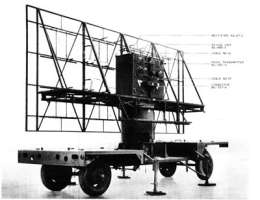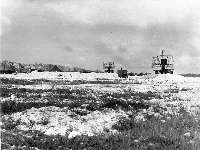SCR-527
Description of the radar set, tactical-technical characteristics

Figure 1: SCR-527 transmitter antenna
 Hersteller:
Hersteller:U.S. Army Signal Corps
| Specifications | |
|---|---|
| frequency: | 209 MHz
(VHF-Band) |
| pulse repetition time (PRT): | |
| pulse repetition frequency (PRF): | 400 Hz |
| pulsewidth (τ): | 1 µs |
| receive time: | |
| dead time: | |
| peak power: | 225 kW |
| average power: | 90 W |
| instrumented range: | 220 km |
| range resolution: | |
| accuracy: | |
| beamwidth: | |
| hits per scan: | |
| antenna rotation: | |
| MTBCF: | |
| MTTR: | |
SCR-527
The SCR-527 (abbr.: of Signal Corps Radio model 527) is an operating in VHF-Band World-War-II Radar for ground controlled intercept (CGI). It used separate antennas for transmission and reception set up about 200 feet apart. The mobile radar set SCR-527A formed a complex that was transported on 7 trucks. The SCR-527 was delivered in the spring of 1943. The crew consisted of 8 men per shift.

